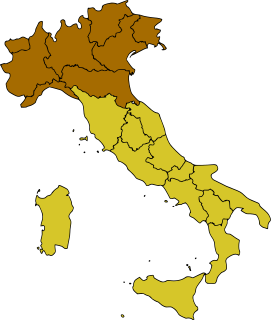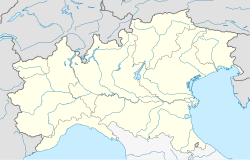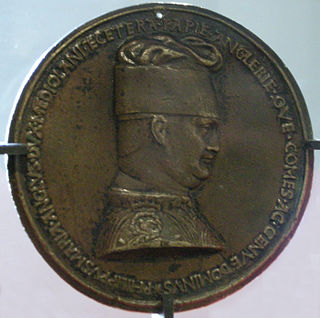
Pavia is a town and comune of south-western Lombardy in northern Italy, 35 kilometres south of Milan on the lower Ticino river near its confluence with the Po. It has a population of c. 73,086,. The city was the capital of the Kingdom of the Lombards from 572 to 774.

Vigevano is a town and comune in the province of Pavia, Lombardy in northern Italy. A historic art town, it is also renowned for shoemaking and is one of the main centres of Lomellina, a rice-growing agricultural district. Vigevano received the honorary title of city with a decree of Duke Francis II Sforza on 2 February 1532. It is famed for its beautiful Renaissance "Piazza Ducale" in the centre of the town.

Magenta is a town and comune in the Metropolitan City of Milan in Lombardy, northern Italy. It became notable as the site of the Battle of Magenta in 1859. The color magenta takes its name from the battle, most likely referring to the uniforms used by Zouave French troops. Magenta is the birthplace of Saint Gianna Beretta Molla (1922-1962).

Visconti is the family name of several Italian noble dynasties of the Middle Ages. One of them, the Visconti of Milan, rose to power in Milan. They ruled there from 1277 to 1447, initially as lords then as dukes, and several collateral branches still exist. The effective founder of the Visconti lordship of Milan was the archbishop Ottone, who wrested control of the city from the rival Della Torre family in 1277.
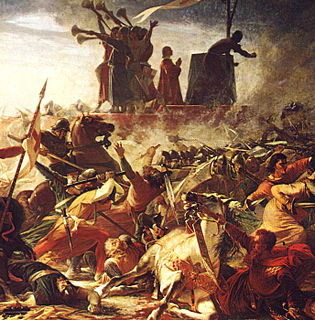
The Battle of Legnano was fought between the imperial army of Frederick Barbarossa and the troops of the Lombard League on May 29, 1176 near the town of Legnano, in present-day Lombardy, in Italy. Although the presence of the enemy nearby was already known to both sides, they suddenly met without having time to plan any strategy.
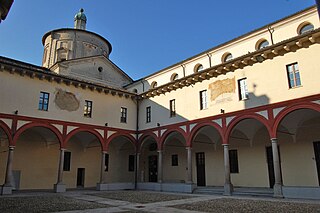
The province of Lodi is a province in the Lombardy region of Italy. Its provincial capital is the city of Lodi. As of 2017, it has a population of 229,541 inhabitants over an area of c. 783 square kilometres (300 sq mi), giving the province a population density of 293.2 inhabitants per square kilometre. The provincial president is Francesco Passerini.

Arona is a town and comune on Lake Maggiore, in the province of Novara. Its main economic activity is tourism, especially from Milan, France and Germany.
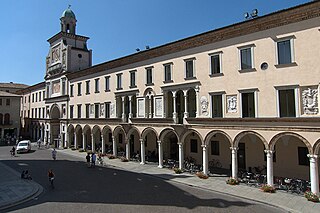
Crema is a city and comune in the province of Cremona, in the region of Lombardy in northern Italy. It is built along the river Serio at 43 kilometres (27 mi) from Cremona. It is also the seat of the Catholic Bishop of Crema, who gave the title of city to Crema.

Sforza Castle is in Milan, northern Italy. It was built in the 15th century by Francesco Sforza, Duke of Milan, on the remnants of a 14th-century fortification. Later renovated and enlarged, in the 16th and 17th centuries it was one of the largest citadels in Europe. Extensively rebuilt by Luca Beltrami in 1891–1905, it now houses several of the city's museums and art collections.

Cassano d'Adda is a town and comune in the Metropolitan City of Milan, Lombardy, Italy, located on the right side of the Adda River. It is on the border of the Metropolitan City of Milan and the province of Bergamo. It is served by Cassano d'Adda railway station.

Abbiategrasso, formerly written Abbiate Grasso, is a comune and town in the Metropolitan City of Milan, Lombardy, northern Italy, situated in the Po valley approximately 22 kilometres from Milan and 38 kilometres from Pavia.

Trezzo sull'Adda is a comune (municipality) in the Metropolitan City of Milan in the Italian region Lombardy, located about 30 kilometres (19 mi) northeast of Milan on the Adda River.

Corbetta is a comune (municipality) in the Metropolitan City of Milan in the Italian region Lombardy.

The Castello Baradello is a military fortification located on a 430 m (1,410 ft) high hill next to the city of Como, northern Italy.

Visconti Castle Italian: Castello Visconteo is a castle in Locarno, Switzerland. It is a Swiss heritage site of national significance.

The Visconti Castle of Binasco is a Middle Age castle located in the center of Binasco, Metropolitan City of Milan, Lombardy, northern Italy. It is famed for having been the prison of Beatrice di Tenda, who was arrested and there sentenced to death for adultery in 1418. Today it is the seat of the municipality of Binasco.

The Dal Pozzo Castle is a castle of Middle Age origin located in Oleggio Castello, Province of Novara, Piedmont, northern Italy. In the 19th century it underwent profound transformations providing it the current neo-Gothic Tudor aspect. Today it is the seat of a hotel.

The Visconti Castle or Castello Visconteo of Cassano is a castle of Middle Age origin located in Cassano d'Adda, Lombardy, northern Italy. It received the current form in the 14th century, when Bernabò Visconti, lord of Milan, enlarged the existing fortification as part of a defensive system of the Visconti dominions on the Adda river. At the end of the 20th century, after a period of abandonment, it was restored and transformed into a hotel.


